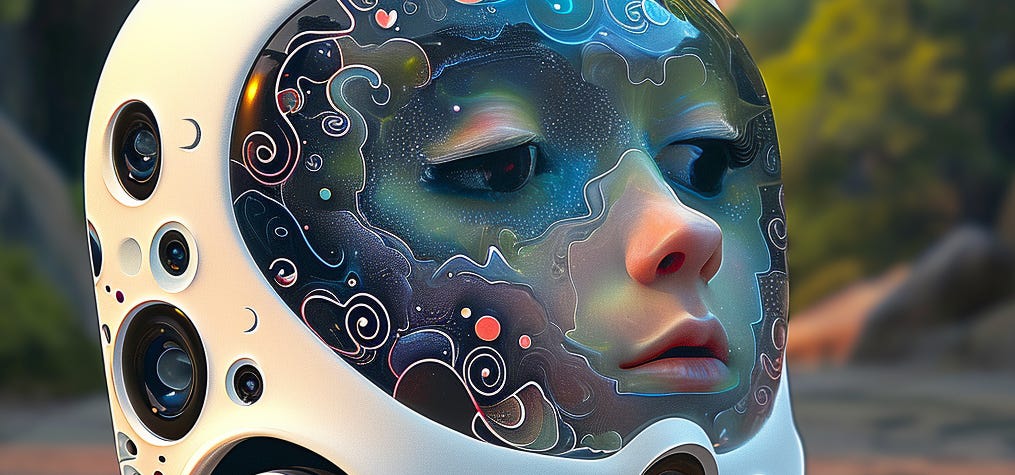Every week, I share in my newsletter, Target is New, a thought triggered by one of the news reads or more general observations. These are often related to the topics that Cities of Things are about: the new interactions of humans and other intelligences in cities and how cities are built by intelligent things. As a new series, I will zoom out a bit more here and revisit the thoughts here. The exact format might change and adapt to the topics.
This Month, I would say that embodied intelligence, with task-based interactions as a new way to interact with increasingly ubiquitous intelligence, is a theme that emerges. I asked a partner-in-crime to merge the different weeks into one overarching theme. ChatGPT, you guessed it right. I specifically prompted it “to create an integrated text that merges the separate week thoughts into the key message the writer (so me) wants to convey. It can use the examples from the chapters, but the output is one text of max 500 words that represents the overarching vision.”
I think the result makes sense…
In the exploration of artificial intelligence's (AI) evolving role within our lives, a vision emerges where AI transcends its initial confines, melding creativity, multimodality, and action-oriented interfaces with the physicality of our daily environments. This integrated approach to AI champions a future where technology not only enhances human creativity and productivity but also harmonizes with our physical world, pushing the boundaries of interaction and societal integration.
The narrative begins with the concept of "mundane AI," illustrating its pervasive influence through generative tools and interfaces like ChatGPT, which have begun to reshape our professional and personal landscapes. This transformation marks a departure from novelty, embedding AI into the fabric of everyday life, thereby challenging us to reconsider the dynamics of creativity, work, and even our social interactions. AI's potential to create personalized bubbles, while fostering a sense of comfort, also poses risks of deepening societal polarization by narrowing our exposure to diverse perspectives.
Moving beyond virtual interactions, the discussion pivots to embodied multimodality, highlighting advancements that bring AI into our physical realm through smart devices and robots. These innovations, exemplified by interconnected smart home ecosystems and the introduction of humanoid robots and action-oriented devices, signal a shift towards a more tangible and multifaceted relationship with technology. This evolution suggests a future where AI assists not merely through screens and speakers but as an integral part of our physical spaces, enhancing our interactions with the environment and each other.
The text further delves into Large Action Models (LAMs) and the concept of the "interverse," envisioning AI's role in creating a seamless blend of digital and physical realities. Here, AI emerges as a dynamic participant in our daily routines, offering tailored actions and interactions that extend beyond conventional applications. This vision of AI as an active agent in our lives underscores a shift towards devices that not only respond to our commands but anticipate and act upon our needs in a more integrated, intuitive manner.
In contemplating the integration of AI into urban environments and public spaces, the notion of "things as citizens" emerges, proposing a future where intelligent devices contribute actively to the fabric of city life. This perspective reimagines the role of AI in smart spatial planning and the management of public spaces, suggesting a collaborative relationship between humans and technology that fosters more responsive, engaging, and sustainable urban ecosystems.
The overarching vision conveyed through these reflections is one of balanced co-evolution, where AI's expansion into our lives and spaces is met with thoughtful consideration of its impacts on creativity, society, and the environment. It advocates for a future where AI serves as a bridge between the digital and physical, enhancing human capabilities and experiences while respecting the values and diversity of human society. Through this integrated approach, AI has the potential to not only transform how we live and work but also to enrich our understanding of ourselves and the world around us.
The sources can be found in the newsletters. Here are also the references that inspired my thoughts per week:
Artificial creativity (2 January)
Embodied multimodality (9 January)
The Vektor example with ChatGPT.
The humanoid robot as robots as appliances.
Storage of your personal AI, or is it more like the “tower of Gal”.
Large Action Model to connect artificial living with real outputs (16 January)
The Rabbit R1 thing tries to create a new interface to LLM in a communication device.
The podcast Dithering has a similar take on this ecosystem of devices.
The interverse with things as citizens (23 January)
Things as Citizens was and is still an inspiring concept
Conference Open and Agile Smart Cities With serious steps in the legal framework; Reference framework for digital twins.
Insane AI-in-a-box with friction-full encounters (30 January)
Design for friction became a topic of discussion.
Matt Webb explores different forms of relationships we will have with AI
Earlier, he wrote about AI's ubiquitous presence in everything we use.
To close, check the Cities of Things website for the latest updates. Check the Wijkbot (Hoodbot) website for the latest urban robots made with the Wijkbot Kit (great for workshops). We have a master's graduation student from Industrial Design Engineering (TU Delft) working on the hub as an engaging neighbour, and we are planning for follow-ups of the Cities of Things LAB010 project. I will keep you posted!
Thanks for reading. Curious to hear your opinion on this new series. Have a great February!








